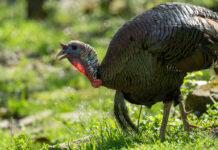This past year was another one that provided opportunities and challenges for crop production, forage management, livestock care and grazing. Most of Ohio experienced some degree of drought, with the southern and southeastern parts of Ohio forced to manage drought conditions of historic proportions.
As we close the year and look forward to 2025, now is a good time to reflect and plan. What did you accomplish in the prior year? What obstacles did you face? What might have you done differently? What do you wish to accomplish in the new year? How will you successfully achieve your goals?
While well-intentioned, it’s easy to get sidetracked and lose sight of the goal(s) you wish to achieve. Setting SMART goals is one approach to improving the likelihood of achieving your goals.
SMART goals
An acronym commonly used to describe effective goals is SMART. Goals must be Specific, Measurable, Action-oriented, Realistic and Timed to be useful management tools.
Goals should be specific and focus on a specific problem or need; measurable and offer means of tracking achievement of goals; action-oriented and offer a pathway to achieving goals; realistic and keeping goals high but within the realm of possibility and timed, including a realistic timeline and a completion date.
Goal setting should include a specific action, an evaluation process and, if needed, refinement of the goal. In this respect, the goal-setting process closely resembles the scientific method. Goal setting is purely an internal function intended solely to benefit your operation or in some cases, just the manager. Developing and refining goals for any operation may be challenging; however, the process should be enjoyable for those involved. If goal setting becomes tedious or exhausting, take a break from it and come back to it at a later time.
There is no finite time frame for goal setting — it is a fluid process that will evolve as an operation grows and changes. Since goals are intended to guide a specific agricultural business, the manager has great latitude in goal setting and the chosen approach to achieving those goals.
Common “goals” include statements like “increase farm income,” “graze more acres” or “produce more pounds of beef.” These are desires, not goals. Think about how these can be rewritten to follow the SMART principles.
SMART in action
Below is an example production goal that will demonstrate the principles that make goals SMART.
Background: Forage quality and quantity in 2024 was less than expected. While drought conditions were likely a contributing factor, it is suspected that soil fertility may be a limiting factor.
Goal: Take soil samples from one-third of grazing acres by March 15, 2025, to determine soil nutrient levels. I will consult with my extension educator to analyze results, develop recommendations and budgets and implement a plan to make needed improvements.
Specific: This goal is specific by describing exactly what will be done, when it will be done and how it will be accomplished.
Measurable: It is easy to measure this goal because of the stated date you plan to complete sampling and the known acres to be sampled.
Action-Oriented: Taking soil samples represents an action item that can be measured.
Realistic: Assuming you have the necessary tools and knowledge, this is a realistic goal. If you lack the equipment or knowledge, consult with your extension educator.
Timed: This goal provides a time element (March 15, 2025) that can be evaluated.
Three categories
As a farm manager, goals can be grouped into three types: personal, production and operational/business.
Personal goals will come in all sizes, but the take-home message is that they must be communicated to others within the business because the manager’s personal goals can have a profound effect on the outcome of business goals.
Production goals involve improving a process within the operation. Production goals are much narrower in scope than operational goals because they pertain to just one piece of the much larger puzzle which is the agricultural business. Agriculture as an industry embraces production goals but many times at the expense of operational or personal goals that are equally important.
While commonly overlooked, operational goals are essential for the long-term growth of any operation. A common operational goal is to accommodate the income needs of the next generation by expanding the operation. Again, the initial step in seeing this goal to fruition requires good communication.
Summary
Projections indicate farm income will be lower in 2025. I encourage you to work with your Extension Educator to analyze where you are, what you wish to accomplish, and how you can develop SMART goals to help you be successful. Select at least one personal, one production and one operational/business goal for the coming year and periodically monitor your progress.
This article summarizes content in OSU Extension Fact Sheet ANR-45, Developing Goals for the Agricultural Business, available at https://ohioline.osu.edu/factsheet/anr-45.













